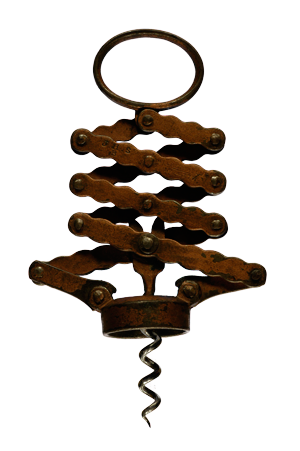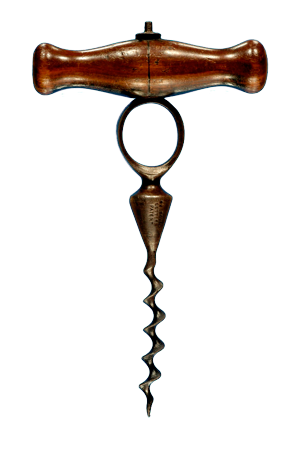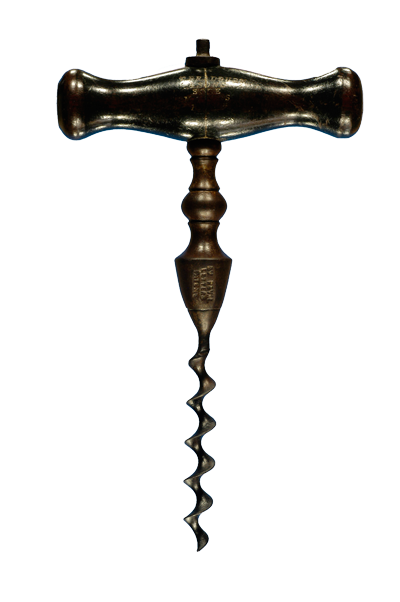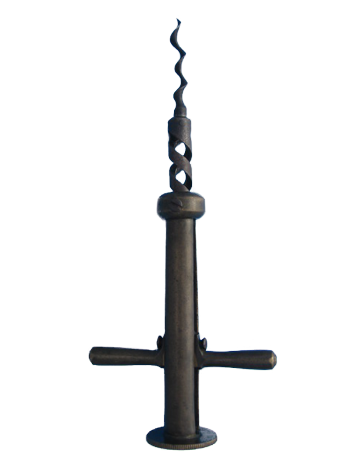Special Corkscrews Page 2
This corkscrew again manufactured in the 19th century. Hipkins was based in Birmingham and interestingly claims to have been established in the 18th century. Hipkins was known to have manufactured CODDS PATENT and WHELANS PATENT corkscrews among others. Hipkins patent has a rack and pinion design and a two section lever arm.

HIPKINS PATENT - marked - G F HIPKINS & SON PATENT/LEVER RACK
Heeley manufactured corkscrews that were examples of his own patent along with Thomason types marked Heeley. He also manufactured all Marshall Wiers patents and made many other things including buckles. He was most proud of his Rhadiographic and Polychronographic Pens. He had a large business when compared to many other corkscrew manufacturers of the same period.

WILLIAM BURTON BAKER PATENT - marked - A1 PATENT/JAMES HEELEY AND SONS PATENT DOUBLE LEVER/PATENT

NEVILLE HEELEY PATENT - marked - THE EMPIRE/ J HEELEY & SONS PATENT
The two images below show two corkscrews patented by Wier. One is a compound lever corkscrew, in fact a double lever with two fulcrum arms each side of a neck ring. The other image shows a compound lever corkscrew of a lighter weight known as the ladies wier. The patentee of these two corkscrews was an engineer who obtained over 100 patents. Wiers corkscrews were manufactured by James Heeley.

MARSHALL WIER PATENT - marked - DOUBLE NO 4283/WIERS PATENT J H S

MARHSALL WIER PATENT - marked - WIER'S PATENT NO 4377 JHS
This patent was manufactured for the patentee Holroyde, by Thomas Bradburn and sons in the 19th century. Bradburn manufactured many tools which were mainly joiners tools.

WALTER HOLROYDE (HOLROYDE II) - marked - BY ROYAL LETTERS PATENT/PATENT CONE CORK SPLITTER 1834/BRADBURN SOLE MAKER

WALTER HOLROYDE PATENT - marked - BY ROYAL LETTERS PATENT. PATENT CONE CORK SPLITTER 1834 BRADBURN SOLE MAKER
An unusual design this patented corkscrew uses two long curved blades to remove the cork from the bottle. Again this is a 19th century piece and is usually found with a wooden handle.

RICHARD BRADNOCK PATENT - marked - MAGIC TWIST/PATENT 3221
Patented by Frederick Whelan, this corkscrew was manufactured in Birmingham by George Twigg. A great deal of force is required to remove the cork as there is no mechanical advantage with this patent.

FREDERICK WHELAN PATENT-marked-PATENT/G.F.HIPKINS
Another corkscrew patented in the 19th century. Again a great deal of force is required to remove the cork as there is no mechanical advantage with this patent.

PITT & NORGROVE PATENT-marked-IMPERIAL MF' G CO.CHICAGO PAT.D AUG 15,82
William Bradford's patented corkscrew from the 19th century was manufactured in two different forms. One with a simple cross bar as in the images below, made for the German market and another form with milled brass disc made for the English market. Both forms have a pawl and ratchet mechanism recessed into the hardwood handle.



WILLIAM HAMILTON KINDERSLEY BRADFORD PATENT - marked - NO MARKINGS
A fantastic direct pressure corkscrew with shallow pitched worm, that enables easy entry into the cork by pushing and turning. There are two variations of this 19th century corkscrew with slightly different markings. One has a bronze barrel and one a steel barrel.


WILLIAM RUSHWORTH PATENT - marked on the top of the knob - THE RUSHWORTH CORKSCREW PATENTED NO 3298
Again there are two variations of this 19th century corkscrew patent. This corkscrew has a similar mechanism to John Coney's patent of 1854. The quality of manufacture is very high and the construction is robust.

HENRY JAMES PERRY PATENT - marked - NO MARKINGS
18TH CENTURY MECHANICAL CORKSCREWS
Two examples of mechanical corkscrews. English in origin from the 18th century. The first example shows how makers in the 18th century had an excellent eye for proportion. The two pieces together demonstrate that makers from the 18th century had a good grasp of mechanical invention. 18th century corkscrews, whether pocket corkscrews or mechanical corkscrews, are hard to find and are prized amongst collectors.

18TH CENTURY TWO PILLAR STEEL ENGLISH CORKSCREW – marked – NO MARKINGS

18TH CENTURY FOUR PILLAR KINGSCREW – marked – NO MARKINGS
Two examples of 19th century corkscrews with registered design protection. Manufactured by William Dray. Both have replaceable worms and are of a high quality of manufacture. William Dray was an Ironmonger based in Birmingham. The registered design protection granted for these corkscrews, refers to the method of fastening the spiral portion of the corkscrew to the stem by use of a dovetail joint.


WILLIAM DRAY THOMASON – marked on badge – W. DRAY REGISTERED MAY 14 1847


WILLIAM DRAY KINGSCREW – marked on badge – W. DRAY REGISTERED MAY 14 1847 LONDON BRIDGE

